Safety Tips
Tips for Safe Boating for Fishermen, Hunters & Campers has been provided courtesy of the United Safe Boating Institute.

Tips for Safe Boating
No matter how many years you've been around boats, please take just five minutes to scan this quick reading booklet. People who hunt or fish from boats have one of the highest boat fatality rates. More die from falling off boats 16 feet and smaller than larger boats, and most boats are anchored at the time.
- Be weather wise. Sudden wind shifts, lightning flashes and choppy water all can mean a storm is brewing. Bring a portable radio to regularly check weather reports.
- Bring extra gear you may need. A flashlight, extra batteries, matches, a map of where you are, flares, sun tan lotion, first aid kit, extra sunglasses. Put those that need to be protected in a watertight pouch or a container that floats.
- Tell someone where you're going, who is with you, and how long you'll be away. Then check your boat, equipment, boat balance, engine and fuel supply before leaving.
- Ventilate after fueling. Open hatches, run blower, and most important, carefully sniff for gasoline fumes in the fuel and engine areas before starting your engine.
- Stay dry and warm. Wear several layers of light clothing; bring rainproof covering. Never wear hip waders in a small boat. Keep fishing and hunting gear clean and well packed. A loose fish hook can cause a lot of pain and ruin a great outing. Bring an extra length of line to secure boat or equipment.
- When changing seats, stay low and near center line of small boat.
- Be ready for trouble when a powerboat passes you in a narrow channel. As the lead boat (which always has the right of way) stay on your side of the channel and maintain a steady speed so that the overtaking vessel can pass you safely. Use your radio to discuss this with the passing boat.
- Anchor from bow, not stern. Use anchor length at least five times longer than water depth.
- Take a safe boating course. As ax extra benefit, you may earn lower boat insurance costs.

Distress Signals
This illustrates the variety and combinations of distress signals which can be carried in order to meet Coast Guard requirements (the arm signals are shown for information only - they are an internationally recognized sign of distress, but are not "required distress signals"). All signals, except for the distress flag and light, must show the words "Coast Guard Approved" and be marked with the service life of the signal. The distress flag and light must carry the manufacturer's certification that they meet Coast Guard requirements.




How You Board and Load Your Boat
Be sure you know your boat's capacity. Look at the Capacity Plate. Don't overload it or put an oversize motor on it. On boats with no capacity plate, use the formula in the sketch at right to determine the maximum number of persons you can carry.
Be sure the dock lines are tied securely before you put gear aboard or go aboard yourself. Don't wind up straddling from dock to boat. If the boat is small, step as near the centerline as possible, and stay low in the boat. As you load, look at how much distance there is between the water and the top edge of your boat (freeboard). Waves, or wakes from passing boats, can easily swamp a small boat with low freeboard. Don't overload. Don't load heavy gear to one side.
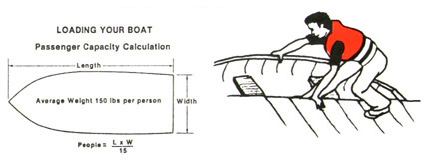

Some Sobering Facts about Alcohol
Four hours of exposure to powerboat noise, vibration, sun, glare, wind and motion produces a kind of "boater's hypnosis". This slows reactions almost as much as being legally drunk. Adding alcohol to this sun exposure intensifies the effects. As the chart shows, sometimes just a couple of beers are too many.
When you're "tipsy", you're much more likely to fall overboard. Alcohol also reduces your body's ability to protect against cold water. So within minutes you may not be able to call for help, or swim to safety. Actually, a drunk person whose head is immersed can be confused and swim down to death instead of up to safety.


First Aid Emergency Measures
INJURY |
SIGNS |
TREAMENT |
Broken Bones |
Pain, swelling, deformity, discoloration and possible bleeding |
Keep broken bone ends and adjacent joints from moving; treat for shock. |
Burns |
1st
- (superficial), involves only the top layer of skin. Skin
is red and dry. |
Cool the burned area with water or ice packs. Do not remove clothes that stick to the skin. Cover the affected area. Give care for shock. For severe burns, get medical attention. |
Sunburn |
Red, painful skin and chills. Fever and shock occasionally accompany severe sunburns. |
Apply cold water. Do not re-expose burned area to sun until completely healed. Get medical attention. |
Cardiac Arrest |
Victim has no pulse and is not breathing. |
Check the vital signs and perform CPR. Get medical assistance. |
Shock |
Pale, clammy skin, irregular breathing, fast, weak pulse. |
Keep person lying down and prevent loss of body heat. Do not give fluids if victim is unconscious. Get medical help as soon as possible. |

Hypothermia- Here's How To Fight This Killer
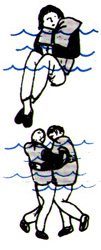
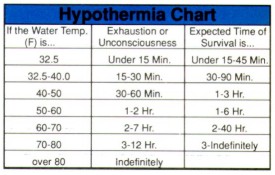
Exposure causes loss of body heat. This is called hypothermia. Hypothermia can kill. Defense against hypothermia is to avoid exposure to cold. Do this by staying dry and avoiding the wind. Put on rain gear before you get wet. If you fall into cold water, DO NOT discard clothing; it will help trap heat. Avoid moving as much as possible. A life jacket helps in two ways: it reduces the need to move, and it helps insulate against heat loss. When you wear a life jacket, draw knees up into a H. E. L. P. (Heat Escape Lessening Position). If several persons are in the water, huddle together so you can conserve heat and stay alive.
Care involves getting the victim out of the wet clothes. Warm the victim gradually by wrapping him or her in blankets or putting on dry clothing and moving into a warm environment. If the victim is alert, give warm liquids to drink that do not contain alcohol or caffeine. DO NOT warm the victim too quickly, by immersing in warm water, for instance, as this can cause dangerous heart rhythms. Transport the victim to a medical facility.

Canoeing

Federal Waterway Marking System
- Keep red aids on your right coming upstream (& in from seaward).
- Keep marked channels clear. Don't anchor in a channel or to a navigational aid.
Lateral Aids marking the sides of channels as seen when entering from seaward
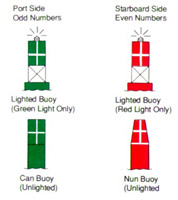
Safe Water Aids marking mid-channels and fairways
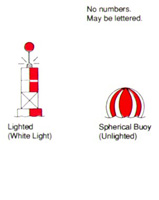
Preferred Channel Aids (Mark bifurcations. No numbers. May be lettered.)
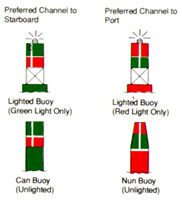

Federal Aids To Navigation
Most areas have government or locally prepared charts available that give water depth, show navigational aids and major landmarks, underwater danger areas, as well as shorelines, waterways and harbor areas.
Some "Uniform State Waterway" aids are shown in the chart sketch. In most areas, Federal waterway aids also would be shown.
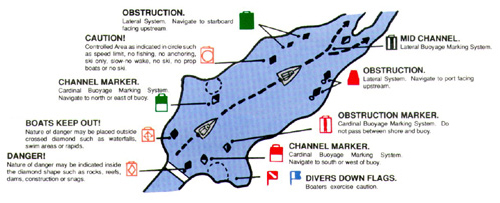

Charts-Your "Road Maps"
- Get and wear a Coast Guard approved Personal Flotation Device (PFD) that fits well; make sure it is the proper type and approved for your specific usage. Actually put it on, adjust it and test it in the water, so you'll know how it will feel when needed. Do the same for all family members - especially children. Knowing what to expect in the water can prevent panic. Non-swimmers should wear a PFD on any small boat.
- Never leave PFDs sealed in plastic wrapping. They must be ready to put on fast.
- Whenever water conditions or weather cause concern, have everybody aboard immediately put on a PFD.
- And if you fall in the water, stay with the boat.

Offshore Life Jackets (Type I): Bulky, but floats you the best: best for open, rough, or remote water. Turns most unconscious persons face-up in the water.
Near Shore Buoyant Vests (Type II): Yoke-type, less bulky than Type I, and more comfortable to wear. Will hold head of many unconscious persons out of water.

Flotation Aids (Type III): Vest style; popular among recreational boaters. Only designed for calm water with good chance of fast rescue. Wearer may have to hold head back to keep face out of water, which can contribute to exhaustion and hypothermia. May not hold face of unconscious wearer out of water.

Throwable Devices (Type IV): Life rings and floating cushions.
Special Use Devices (Type V): Approved only for the activities listed on the label. Some are approved specifically for white water rafting, board sailing, etc. Also includes new hybrid PFDs with foam flotation and an inflatable chamber. Type V Hybrid PFDs are as comfortable to wear as a Type III, but when fully inflated have the flotation performance of a Type II or better.

Federal Law Says You Must Have This Aboard
Equipment |
Less than 16 feet |
Less than 26 feet |
Life Jackets (PFDs) |
One Type I, II, III, IV, or Hybrid Type V for each person. Hybrid Type V must be worn at all times to meet Coast Guard regulations. |
One Type I, II, III, or Hybrid Type V for each person on board or being towed on water skis, etc., plus one Type IV available to be thrown. Hybrid Type V must be worn at all times to meet Coast Guard regulations. |
Fire Extinguishers |
At least one B-1 Coast Guard approved type hand portable fire extinguisher. Not required on outboard motorboats less that 26 feet in length if the construction of such motorboats will not permit the entrapment of flammable gases or vapors. |
|
Ventilation |
At least two ventilator ducts fitted with cowls for the purpose of properly and efficiently ventilating the bilges of every inboard engine and fuel tank compartment of boats constructed or decked over after 25 April 1940, using gasoline or other fuel having a flashpoint less than 110 degrees F. Boats built after 31 July 1980 must have operable power blowers. |
|
Whistle, Bell or Horn |
Any device capable of making an "efficient sound signal" audible for ½ mile. |
|
|
One Coast Guard approved device on each carburetor of all gasoline engines installed after 25 April 1940, except outboard motors. |
|
Visual Distress Signals - for coastal waters, Great Lakes or high seas |
Required only when operating at night (N). Same night equipment choices as for larger boats. |
Orange flag with black square-and-disc(D); and an S-O-S electric light (N); or 3 orange smoke signals, hand held or floating (D); or 3 red flares of hand held, meteor, or parachute type (DN). |

Operating Rules
You are legally responsible for the safety of those on your boat, any damage your boat causes to other boats and property, and all others injured by any damage you cause. Just like driving a car, if you don't know and obey the rules, the fact that you didn't know them is NOT a valid defense. Important: The law also says you're guilty if you cause an accident because you're "right" and therefore elect not to prevent the accident. These drawings show some (but not all) "right of way" rules. (Horn signals and navigation lights are not covered here.)

Crossing: Every boat has a danger zone from straight in front {the bow} to past the middle of its right side. Like when meeting another car at a street intersection, the one on the right has the right of way. You must yield to boats in your danger zone.

Powerboats must yield to sailboats and boats being rowed or paddled, except in a narrow channel. Stay well clear of all big vessels.
Overtaking: Be ready for trouble when a power boat passes you in a narrow waterway. As the lead boat (which always has the right of way) stay on your side of the channel and maintain a steady speed so that the overtaking vessel can pass you safely. Use your radio to discuss this with the passing boat.

Meeting: As in a car, both stay to your right and as far apart as practical, so it's easier and safer to cross each other's wake. (Okay to pass left, if both know the plan.) Give notice by steering to right or left while still far apart. Then stay with that plan unless the other boat indicates otherwise. If you have a CB or VHF, use it. Be careful.

Take a Boating Course
United States Power Squadrons
The USPS Boating Course offers the basics of safer and more enjoyable boating. Whether you own a boat, are thinking of buying one, or enjoy boating with friends, all instruction is free. There is a nominal charge to cover costs including a 150-page student workbook and chart. The course is offered as a public service in over 500 local areas throughout the U. S. A. Instructors are volunteer USPS members. The course is also available in video form. For information call: 1-800-828-3380.
United States Coast Guard Auxiliary
Coast Guard Auxiliary, created by act of Congress in 1939, is the volunteer civilian arm of the United States Coast Guard. In promoting safe boating in the U. S. A , it performs these non-profit services:
- Teaches several public boating courses.
- Examines recreational boats for proper safety equipment.
- Assists regular Coast Guard in search & rescue, and patrols navigable and state waterways.
For more free information on boating safety (including safety recalls) call: 1-800-368-5647.
United States Sailing Association
National governing body for sailing, USSA is also a membership organization of 25,000 active sailor and sailing groups. Programs include instructor training, sailing safety, and services to sailing groups. Membership benefits include discounts on sailing publications, videos, and travel; monthly "American Sailor" magazine. For information call (401) 849-5200 or write USSA, Box 209, Newport, RI 02840.
American Red Cross
By congressional charter, the ARC is responsible for relieving and preventing accidents and suffering. The aim of the organization is to improve the quality of human life and to enhance individual self-reliance and concern for others. It provides standards, courses, and materials in first aid, CPR, swimming, lifesaving, lifeguarding, and boating safety (canoeing, kayaking, sailing.)

